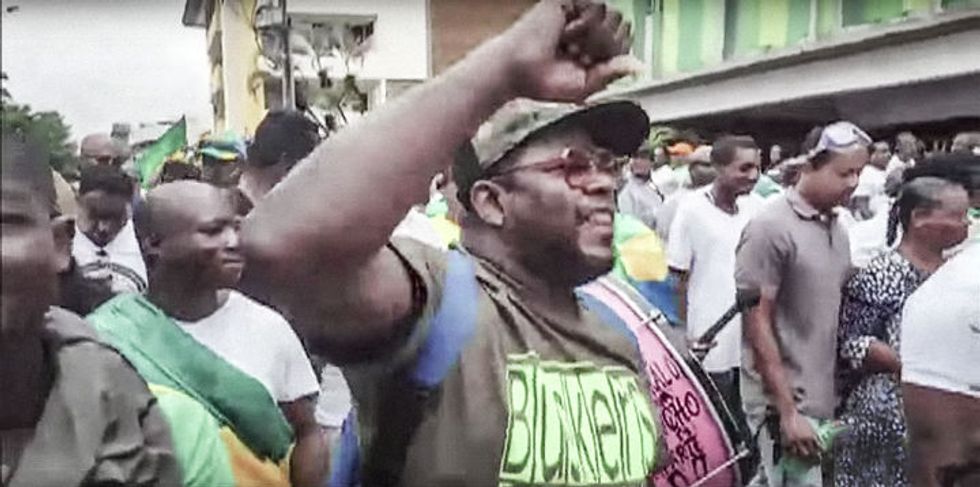Afro-Colombians Are on Strike—Here's Why
Residents of the blackest part of Colombia, the Pacific coast, recently went on strike to protest centuries of neglect at the hands of the central government. But why now?

Afro-Colombians are on strike. To be precise, residents of the blackest part of Colombia, the Pacific coast, recently went on strike to protest centuries of neglect at the hands of the central government. But why now?
With the disarmament of the Armed Revolutionary Forces of Colombia (FARC) guerrillas, only now does Colombia seem ready to pay attention to its worst social issues—some of which have been buried by an armed conflict that has lasted over five decades. And with an economic surplus thanks to the peace, many are asking the government for investment to correct a history of neglect.
In May, President Juan Manuel Santos had to face three popular strikes taking place at the same time—public school teachers, the residents of Buenaventura, and the citizens of the region of Chocó all decided to halt their activities and march.

But while the teachers’ strike that only ended Friday was a nationwide issue, the strikes in Buenaventura and Chocó shared a localized, defining characteristic: they are both places in Colombia’s Pacific Coast, historically one of the poorest and most underdeveloped areas of Colombia, and their population is overwhelmingly black.
The Pacific coast of the country was settled mostly by escaped and freed slaves who looked to distance themselves from their former masters. Because of this, this part of the country has often been perceived as savage and unworthy of investment. In 2012, for example, Rodrigo Mesa, an Assemblyman in Antioquia, a region neighboring Chocó, said that sending money to Chocó was like “putting perfume on a turd.”
That might have been the impolite outburst of an unknown politician, but it signified centuries of oversight, the casting of Chocó – and, by extension, the black areas of the Colombian Pacific – as an irredeemable place. This structural neglect led to deep crises which exploded in the mass movements of last month.
Buenaventura, a city in the Valle del Cauca region, is the largest (and one of only two) Colombian port in the Pacific Ocean, but its strategic commercial position has not translated into wealth for its inhabitants. Rather, it has become a curse. Various illegally armed groups (paramilitaries, guerrillas, narcos, and gangs) dispute its territory, as it is perfectly located to ship drugs north and receive other illegal contraband. Extortion, kidnappings and murders are common here. It is also the epicenter of a Colombian epidemic known as “casas de pique,” houses where people are tortured and dismembered, mostly by paramilitary groups trying to instill fear.

And so, while most of the city’s approximately 400,000 inhabitants live in fear, they also lack running water, legal job opportunities, quality hospitals, schools, roads, and recreational spaces. This is why various civic organizations in the city, with the support of the local Catholic church, decided to strike by stopping Buenaventura’s commercial activity and blocking trucks trying to leave town with goods that arrived to the port. They wanted to impact the national economy and to pressure the government into investing immediately in the city and changing legislation so more of the money produced by the port would stay in Buenaventura’s public projects.
At about the same time, various civic organizations in Chocó – a region north of Valle del Cauca which is about 96 percent black and one of the poorest in the country – decided to also go on a general strike. Many citizens in the region’s biggest cities – such as the capital Quibdó, or other important urban centers like Itsmina, Juradó and Apartadó – decided to stop working and opening their businesses, to pressure the national government into delivering on the promises they made during Chocó’s 2016 general strike: money for security, roads, schools, hospitals, and a decades-old promise to create an energy grid that will end the dependency of 11 of the 30 towns in the region on fuel-powered plants for their electricity.
They were also demanding the official inclusion of Belén de Bajirá – a town that is part of Chocó, but has been claimed by Antioquia for 17 years – in Chocó in the newly published national map.
At first, the strikers in Buenaventura and Chocó had a party on the streets to demand their rights.
https://www.youtube.com/watch?v=qqD9ppFmE7c
But on May 19, talks between Buenaventura’s strike organizers and government representatives hit a rough patch. The Police left the negotiating table and, four hours later the ESMAD (Colombia’s militarized riot police) started to roam the city.
The situation escalated into looting and a repression by the ESMAD that many social activists described as human rights abuses. The ESMAD was deployed in Chocó as well, and the images that surfaced earlier of protests full of music and dancing started to be replaced by images of bloodied civilians.
However, after about a month of meetings between strike organizers and government representatives, including ministers and U.N. delegates, Chocó decided to end their general strike on May 27. A few days later, on June 6, Buenaventura did the same. Both managed to draw some promises and accords from the government, but the past month meant much more to these places.
“We showed the world that the people of Buenaventura are great, important, and able,” said Víctor Vidal, one of the strike leaders, to local outlet La Silla Pacífico as the general strike came to an end. “We have always been that, but sometimes we forget it. But now … we managed to mobilize Colombia, to mobilize the world in solidarity with us.”

